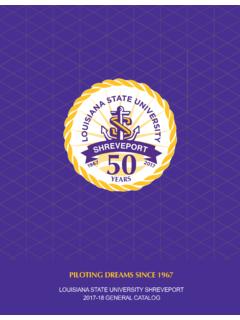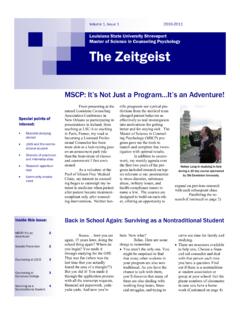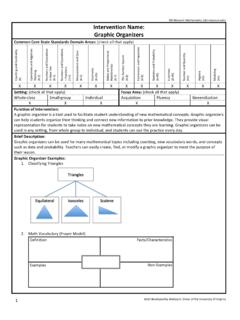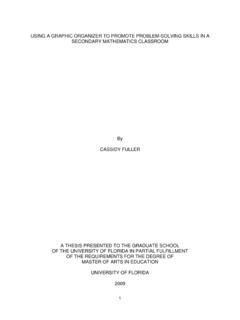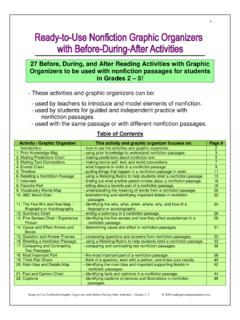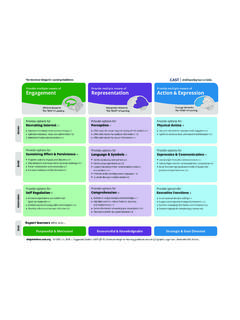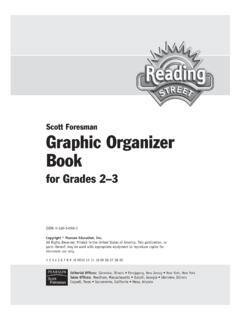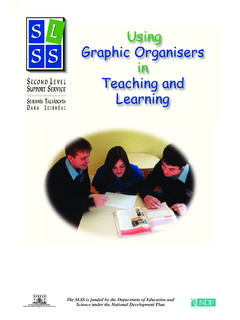Transcription of Graphic Organizers - LSU Shreveport
1 Graphic Organizers Prepared by Tracey Hall & Nicole Strangman National Center on Accessing the General Curriculum Introduction One way to help make a curriculum more supportive of students and teachers is to incorporate Graphic Organizers . Graphic Organizers come in many varieties and have been widely researched for their effectiveness in improving learning outcomes for various students. The following five sections present a definition of Graphic Organizers , a sampling of different types and their applications, a discussion of the research evidence for their effectiveness, useful Web resources, and a list of referenced research articles. We have focused this overview on applications of Graphic Organizers to reading instruction, with the intention of later expanding the discussion into other subject areas.
2 Definition A Graphic organizer is a visual and Graphic display that depicts the relationships between facts, terms, and or ideas within a learning task. Graphic Organizers are also sometimes referred to as knowledge maps, concept maps, story maps, cognitive Organizers , advance Organizers , or concept diagrams. Types of Graphic Organizers Graphic Organizers come in many different forms, each one best suited to organizing a particular type of information. The following examples are merely a sampling of the different types and uses of Graphic Organizers . A Descriptive or Thematic Map works well for mapping generic information, but particularly well for mapping hierarchical relationships. Organizing a hierarchical set of information, reflecting superordinate or subordinate elements, is made easier by constructing a Network Tree.
3 When the information relating to a main idea or theme does not fit into a hierarchy, a Spider Map can help with organization. Graphic Organizers Page 1 March 2002. When information contains cause and effect problems and solutions, a Problem and Solution Map can be useful for organizing. A Problem-Solution Outline helps students to compare different solutions to a problem. A Sequential Episodic Map is useful for mapping cause and effect. When cause-effect relationships are complex and non-redundant a Fishbone Map may be particularly useful. A Comparative and Contrastive Map can help students to compare and contrast two concepts according to their features. Another way to compare concepts' attributes is to construct a Compare-Contrast Matrix.
4 Continuum Scale is effective for organizing information along a dimension such as less to more, low to high, and few to many. Graphic Organizers Page 2 March 2002. A Series of Events Chain can help students organize information according to various steps or stages. A Cycle Map is useful for organizing information that is circular or cyclical, with no absolute beginning or ending. A Human Interaction Outline is effective for organizing events in terms of a chain of action and reaction (especially useful in social sciences and humanities). Applications Across Curriculum Areas Graphic Organizers have been applied across a range of curriculum subject areas. Although reading is by far the most well studied application, science, social studies, language arts, and math are additional content areas that are represented in the research base on Graphic Organizers .
5 Operations such as mapping cause and effect, note taking, comparing and contrasting concepts, organizing problems and solutions, and relating information to main ideas or themes can be beneficial to many subject areas. The observed benefits in these subject areas go beyond those known to occur in reading comprehension (Bulgren, Schumaker, & Deshler, 1988; Darch, Carnine, & Kammenui, 1986; Herl, O'Neil, Chung, & Schacter, 1999; Willerman & Mac Harg, 1991). Evidence for Effectiveness There is solid evidence for the effectiveness of Graphic Organizers in facilitating learning. Ten of the 12 studies investigating effects of Graphic organizer use on learning reviewed here reported some positive learning outcome.
6 We focus this overview on two main areas: comprehension and vocabulary knowledge. Comprehension By far the most frequently investigated learning measure in the studies we reviewed is comprehension. Of 15 studies, 7 (Boyle & Weishaar, 1997; Bulgren et al., 1988; Darch et al., 1986; Gardill & Jitendra, 1999; Idol & Croll, 1987; Sinatra, Stahl-Gemake, & Berg, 1984;. Willerman & Mac Harg, 1991) reported that Graphic organizer use elevated comprehension. Comprehension measures included the Stanford Diagnostic Reading Test (Boyle & Weishaar, 1997), comprehension questions (Alvermann & Boothby, 1986; Boyle & Weishaar, 1997; Darch et al. 1986; Gardill & Jitendra, 1999; Idol & Croll, 1987; Sinatra et al, 1984), a concept acquisition test (Bulgren et al.)
7 , 1988), teacher-made tests (Bulgren et al., 1988; Willerman &. Mac Harg, 1991), written summaries (Gallego et al., 1989), and story grammar tests (Gardill &. Jitendra, 1999). The reliability of these improvements in comprehension is further supported by Graphic Organizers Page 3 March 2002. Moore and Readence's (1984) metaanalysis. When looking across 23 different studies they found a small but consistent effect on comprehension. Although 3 studies reported no effect of Graphic organizer use on comprehension, these findings appear to be attributable to deficiencies in experimental design. Carnes, Lindbeck, & Griffin (1987) reported no effect of advance organizer use relative to non-advance organizer use on the comprehension of microcomputer physics tutorials.
8 However, students in this study were not trained to use the advanced Organizers . This same factor may account for the lack of effect in the Clements-Davis & Ley (1991) study, where high school students received no instruction on how to use the thematic pre- Organizers that they were given to assist story reading. Alvermann and Boothby (1986) also failed to demonstrate an improvement in comprehension. In this case, the lack of improvement is quite likely due to a ceiling effect as comprehension scores were quite high even before the intervention. Thus, weighing the collective evidence there still appears to be strong support for the ability of Graphic Organizers to improve reading comprehension. Vocabulary Knowledge Moore and Readence's (1984) meta-analysis suggests that gains in vocabulary knowledge following Graphic organizer use may be even greater than gains in comprehension.
9 The average effect size for the 23 studies reviewed was more than twice as large as that reported for comprehension. Thus, Graphic Organizers appear to be a very effective tool for improving vocabulary knowledge. Factors Influencing Effectiveness Research studies have established that successful learning outcomes in the areas described above are contingent on certain factors. Important variables include grade level, point of implementation, instructional context, and ease of implementation. We elaborate the influence of these variables here. Grade Level Successful learning outcomes have been demonstrated for students with (Anderson-Inman, Knox-Quinn, & Horney, 1996; Boyle & Weishaar, 1997; Bulgren et al.)
10 , 1988; Gallego et al., 1989; Gardill & Jitendra, 1999; Idol & Croll, 1987; Newby, Caldwell, & Recht, 1989; Sinatra et al., 1984) and without (Alvermann & Boothby, 1986; Bulgren et al., 1988; Darch et al., 1986;. Willerman & Harg, 1991) learning disabilities across a range of grade levels, including elementary, junior high, and high school. However, on average the largest effects of Graphic Organizers on learning from text have been reported for University populations (Moore &. Readence, 1984). There are consistent although more modest effects for elementary populations (Moore & Readence, 1984). Point of Implementation Graphic Organizers may be introduced as advance Organizers , before the learning task, or as post Organizers , after encountering the learning material.
